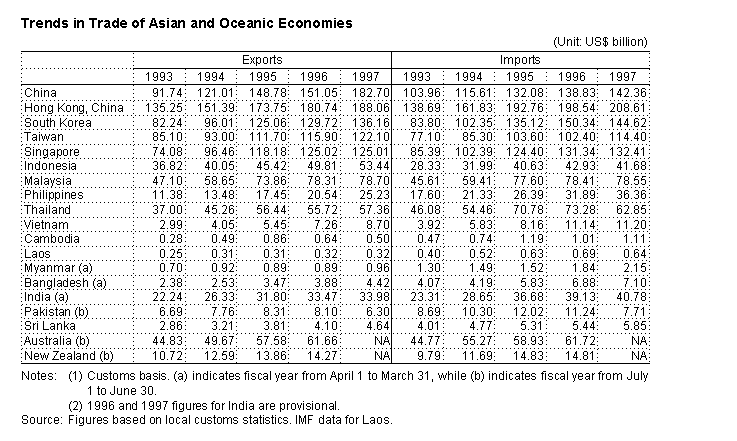According to the Asian Development Bank (ADB), real economic growth
in Asia in 1997 slowed to 6.1%, below the 8.2% for 1995 and 7.5% for 1996,
due to the effects of the Asian currency and economic crisis. The economies
of South Korea and the ASEAN4 were particularly hard hit, and growth rates
in all five countries were below 1996 levels. Economic activity has also
dropped dramatically, and South Korea, Indonesia, Thailand and Malaysia
all posted negative economic growth rates for the first quarter of 1998.
With production adjustments, bankruptcies and increasing unemployment,
East Asia has entered a deep recession. Inflation in the Asian region,
on the other hand, fell from 9.4% in 1995 to 6.1% in 1996 due to anti-inflationary
policies of financial and monetary restraint in countries in the region,
and despite the devaluation of East Asian currencies in the second half
of 1997, inflation declined again in 1997 to 5.6%. However, ADB forecasts
that it will rise to 12.9% in 1998 due to the deepening of economic crisis. According to the ADB, exports of manufactured goods in the Asian region
grew an extremely strong 18.3% in 1994 in terms of value and 22.1% in 1995.
The rate of growth in exports then slumped to 6.8% in 1996 and 7.2% in
1997. An examination of exports by country and region in 1997 shows that
while exports registered strong growth of over 20% in China, the Philippines
and Vietnam, there was a year-on-year decline in countries such as Singapore,
Malaysia and Pakistan, where trends of sluggishness in exports sharpened.
The reasons for the slump in exports include (1) the slowdown in exports
bound for East Asia where the currency and economic crisis occurred, and
(2) the fact that the sudden fall in the value of local currencies did
not lead directly to an increase in exports in those countries as production
activities were hindered by the difficulty of raising funds due to the
credit squeeze and the soaring cost of imported materials.
Asian countries basically have a positive attitude towards trade liberalization.
However, some countries have taken retrogressive action (e.g. raising tariffs
on specific categories of imports) to protect domestic industries hit by
the effects of the currency and economic crisis. Malaysia, for example,
took a step back from trade liberalization when it announced in October
1997 that it would raise the import duties on construction machinery and
materials and consumer durables in order to restrict imports and improve
the trade deficit. Thailand is raising the import duties on intermediate
goods in order to protect domestic manufacturers in specified industries
(e.g. in the iron and steel industry) affected by a slump in domestic demand
caused by effects of the currency crisis. The Philippines also conducted
a major revision of tariffs in January 1998 and increased the import duties
on imports such as complete knockdown (CKD) parts for assembly of passenger
cars and commercial vehicles, cement, and iron and steel.
Australia, on the other hand, decided in November 1997 to cut tariffs
on automobiles, textiles, clothing and footwear by 2005 and join the Information
Technology Agreement (ITA). New Zealand is also proceeding with a policy
of liberalization. It brought forward to May 1998 the abolition of import
duties on automobiles announced in December 1997 and originally scheduled
for implementation by the end of 2000.
Due to the deepening currency crisis, there has been a relative decline
in interest among foreign-affiliated firms regarding the approval of the
ASEAN Industrial Cooperation Scheme (AICO). Foreign-affiliated firms, Japanese
firms in particular, are instead seeking to develop new export markets
as they reconsider their business activities in Asia in the light of the
deepening currency crisis. Although bilateral moves towards deregulation
can be seen in South Asia, such as India*s lowering of tariffs on imports
from Sri Lanka, intra-regional trade in the South Asian Association for
Regional Cooperation (SAARC) is weak. The South Asian Preferential Trading
Arrangement (SAPTA) established in December 1995 is limited in its effectiveness,
and mutually complementary relations in the region are insufficiently developed.
Imports from the ASEAN4, which had grown by 20.0% on the previous year
in 1995 and by 9.0% in 1996, also shrank by 2.5% in 1997. This was due
to an 8.7% drop in the second half of 1997 despite a 4.1% rise in the first
half on the same period in the previous year. Japan*s imports from East
Asian countries and regions in 1997 dropped across the board due to the
slump in domestic demand in Japan; imports from Singapore were down 19.7%,
Taiwan down 16.4%, Hong Kong, China down 12.6% and South Korea down 8.5%.
(2) Changes in Trade Environment
(3) Developments in Trade with Japan
With exports and imports alike growing increasingly sluggish, Japan's
trade with East Asia remained depressed in 1997. Exports to the ASEAN4
fell by 4.4% in 1996 and declined further in 1997 by 5.9% on a U.S. dollar
basis. Exports to Thailand fell particularly precipitously in the second
half of 1997 by 28.2% on the corresponding period a year ago, and slumped
by 20.1% on a year basis. Exports to South Korea, too, which had fallen
by 5.9% in 1996, fell further by 11.0% in 1997.
